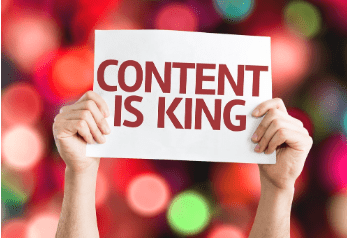Inbound-Marketing: Strategien zur Kundengewinnung und -bindung
In der digitalen Welt, in der wir leben, ist es kein Wunder, dass sich immer mehr Unternehmen digitalen Marketinginitiativen zuwenden, um ihren Gewinn zu steigern. Wenn es um Ihre digitale Präsenz geht, reicht es nicht mehr aus, einfach nur online zu sein.
Die meisten Vermarkter wissen, dass die Kunden das Internet nutzen, um das zu finden, was sie suchen. Eine kürzlich von Fleishman-Hillard durchgeführte Studie ergab, dass 89 % der Verbraucher ihre Kaufentscheidung mit einer Suchmaschine treffen.
Dies stellt Unternehmen wie das Ihre vor zwei brennende Fragen: "Wie bringen wir unsere Website an die Spitze der Ergebnisseite? Und wie wandeln wir Besucher in Kunden um, sobald sie auf unserer Website sind?"
Im Jahr 2006 prägte HubSpot denBegriff "Inbound Marketing" und definierte ihn wie folgt:
Inbound-Marketing ist eine Geschäftsmethode, die Kunden durch die Erstellung wertvoller, auf sie zugeschnittener Inhalte und Erfahrungen anzieht. Während Outbound-Marketing Ihre Zielgruppe mit Inhalten unterbricht, die sie nicht immer wünscht, stellt Inbound-Marketing Verbindungen her, nach denen sie sucht, und löst Probleme, die sie bereits hat.
Was genau sind also die Vorteile des Inbound-Marketings, und wie hilft es Unternehmen, relevante Besucher anzuziehen und sie in Leads umzuwandeln?
1. Inbound bringt die Leads zu Ihnen
Inbound-Marketing ist ein echtes Produkt des digitalen Zeitalters. Es ist ein einzigartiger Ansatz des 21. Jahrhunderts, der im Gegensatz zu traditionellen Methoden der Kundenansprache steht, wie z. B. Printanzeigen, Radiowerbung, Plakatwerbung und Telefonmarketing. Dabei handelt es sich eher um einen "Schrotflinten-Ansatz", dem es an Zielgerichtetheit und Fokus fehlt.
Obwohl diese Strategien immer noch verwendet werden, stellen immer mehr Vermarkter fest, dass sie mit Inbound ein viel gezielteres Publikum erreichen und sich auf die spezifischen Probleme der Kunden konzentrieren können. So können sie gezielt darauf reagieren und helfen.
Durch die Erstellung von Blogbeiträgen, die den Menschen relevante, aktuelle und interessante Kurzinformationen über den Zustand Ihrer Branche bieten, positionieren Sie Ihre Website als Quelle hochwertiger Informationen, die potenzielle Kunden dazu bringen, immer wieder zu kommen.
Es gibt zahlreiche Social-Media-Plattformen, auf denen Sie zu diesen informativen Beiträgen auf Ihrer Unternehmenswebsite verlinken können. Dies ist eine weitere Möglichkeit, die Aufmerksamkeit auf Ihre Unternehmenswebsite zu lenken und gleichzeitig zusätzliche Möglichkeiten zu schaffen, mit denen Ihre bestehenden und potenziellen Kunden mit Ihnen und Ihrem Unternehmen interagieren können.
Diese wiederholten Besuche werden dazu führen, dass mehr potenzielle Kunden zu zahlenden Kunden werden, wenn sie sehen, wie Ihre Inhalte die Interaktion fördern. Dadurch bleiben die Besucher länger auf Ihrer Website und werden ermutigt, andere Seiten zu besuchen, um mehr über Sie und Ihr Unternehmen zu erfahren. Und das zusätzliche Engagement und die Interaktion in den sozialen Medien geben Ihnen zusätzliche Möglichkeiten, zu erklären, wie Sie bei der Lösung ihrer Geschäftsprobleme helfen können.
Und das Beste daran? All diese Kunden werden auf Ihre Website gelockt, ohne dass Sie sie direkt ansprechen und ohne dass Sie ihnen etwas verkaufen müssen!
2. Engagement führt zu Vertrauen
Jetzt, da Ihre potenziellen Kunden Ihre Website über die von Ihnen auf verschiedenen Kanälen veröffentlichten Inhalte gefunden haben, ist es an der Zeit, ihr Vertrauen zu gewinnen. Indem Sie relevante Informationen zu ihren Problemen vermitteln, verschaffen Sie Ihrem Unternehmen eine Vertrauensposition.
Laut einer Studie von Demand Gen Report sehen sich 47 % der Käufer mindestens 3 bis 5 Inhalte an, bevor sie sich für ein Gespräch mit einem Unternehmensvertreter entscheiden. Indem Sie auf nicht aufdringliche Weise zeigen, dass Sie eine wertvolle Ressource sein können, legen Sie den Grundstein für eine Beziehung, die auf wertvollen Inhalten und Vertrauen basiert.
Dieser direkte Kontakt zwischen dem Kunden und Ihrem Unternehmen ist Ihre Chance, klar und deutlich zu zeigen, wie Sie seine Probleme lösen können. Der Kunde befindet sich nun in der Mitte des Verkaufstrichters, und es ist an der Zeit, ihn mit noch mehr Ihrer großartigen Inhalte zu begeistern und ihn in die letzte Phase eines zufriedenen Kunden zu überführen.
3. Ergebnisse führen zu besseren Strategien
Inbound-Marketing-Strategien sind voll von klaren, messbaren Aktionen. Dies führt zu Daten, die Sie sammeln und als Instrument nutzen können, um zu sehen, was funktioniert und was nicht, und zwar viel schneller als bei herkömmlichen Marketingmethoden. Sie können erkennen, welche Inhalte das Engagement steigern und wo es Möglichkeiten für die Umsetzung künftiger Strategien gibt. Sie werden auch sehen, welche Inhalte vielleicht nicht so gut ankommen und können diese aus Ihren Plänen streichen.
Bei Inbound-Methoden wird beispielsweise erfasst, wie lange sich jemand ein Video ansieht, welche Seiten er sich ansieht, wie viele Downloads eines Ebooks es gibt usw. Anhand dieser Daten können Sie Ihre neuen Inhalte auf das abstimmen, wonach die meisten Menschen bereits suchen und womit sie sich beschäftigen.
4. Kosteneffizienz ist wichtig
Wie Benjamin Franklin im Jahr 1748 sagte: "Zeit ist Geld". Da Sie mit Inbound-Marketing Ihre Botschaft auf relevante Besucher zuschneiden und dann mit ihnen in Kontakt treten können, bis sie zu Kunden werden, können Sie genau festlegen, wohin Ihre Marketinggelder fließen. Indem Sie nur relevante Inhalte erstellen, von denen Sie wissen, dass potenzielle Kunden danach suchen, können Sie Verschwendung vermeiden, indem Sie keine Ausgaben für Anzeigen tätigen, die niemand sieht.
Inbound ist zwar keine allumfassende Marketingstrategie, ermöglicht Ihnen aber eine Umverteilung Ihrer Gelder zugunsten effektiverer Ausgaben.
5. Eine langfristige Strategie wird nachhaltige Ergebnisse erzielen
Die Entwicklung einer Inbound-Marketingstrategie erfolgt nicht über Nacht. Die Entwicklung einer Strategie und die Festlegung realistischer Ziele und Erwartungen erfordert Zeit und Planung. Anschließend nutzen Sie die gesammelten Daten zur Feinabstimmung und Neukalibrierung Ihrer Inhalte und erreichen so noch mehr Zielgruppen mit noch weniger verschwendeten Ausgaben.
Eine langfristige Strategie wie das Inbound-Marketing ermöglicht es, nachhaltigere Ergebnisse zu erzielen. Sie erstellen eine Datenbank mit relevanten und ansprechenden Artikeln, Videos und anderen Inhalten, die Sie über Jahre hinweg nutzen können, um neue Kunden anzulocken und zu gewinnen.
Dann kann das Mund-zu-Mund-Propaganda-Marketing in Gang kommen, indem diese zufriedenen Kunden ihrem Netzwerk von Ihrem Unternehmen und der Lösung ihrer Probleme erzählen. Sie werden gerne erzählen, wie vertrauenswürdig und sachkundig Sie in Ihrem Bereich sind und wie sehr diese anderen Unternehmen von einer Zusammenarbeit mit Ihnen profitieren werden.
Schon bald werden Sie eine Armee zufriedener Kunden haben, die Ihr Marketing für Sie übernehmen!
Kernelemente des Inbound-Marketing
Im Folgenden finden Sie einige der wichtigsten Komponenten des Inbound-Marketings:
-
Erstellung von Inhalten: Erstellen von Inhalten wie Blogs, Whitepapers, eBooks, Webinaren, Podcasts und Videos, um potenzielle Kunden anzuziehen und ihnen einen Mehrwert zu bieten.
-
Suchmaschinen-Optimierung (SEO): Optimierung von Website-Inhalten und -Strukturen, um das Ranking der Website in Suchmaschinen zu verbessern und so die Sichtbarkeit und den organischen Traffic zu erhöhen.
-
Social Media Marketing: Bewerbung von Inhalten und Kontaktaufnahme mit potenziellen Kunden über Social-Media-Plattformen wie Twitter, Facebook, Instagram und LinkedIn.
-
E-Mail-Marketing: Pflege von Leads durch gezielte E-Mail-Kampagnen und personalisierte Nachrichten, um sie zu informieren und durch den Kaufprozess zu führen.
-
Landing Pages: Erstellung spezieller Landing Pages für bestimmte Produkte, Dienstleistungen oder Kampagnen, um Leads zu erfassen und Konversionen zu fördern.
-
Lead-Magnete: Angebot wertvoller Ressourcen wie kostenlose Testversionen, Demos, Leitfäden und Vorlagen im Austausch gegen Kontaktinformationen, um so Leads zu generieren.
-
Analysen und Berichte: Messung des Erfolgs von Inbound-Marketing-Maßnahmen durch Verfolgung und Analyse von Website-Traffic, Konversionsraten, Engagement-Metriken und ROI.
Dieser Beitrag ist auch verfügbar in:
- Englisch: Discover Inbound Marketing Insights: Boost Your Strategy
- Spanisch: Descubra técnicas del Inbound Marketing: Impulse su estrategia
- Französisch: Boostez Votre Stratégie avec l'Inbound Marketing en 2025
- Italienisch: Strategia Inbound Marketing: Come Attirare e Convertire Clienti Online
- Rumänisch: Inbound Marketing: Cum să Atragi și să Convertești Clienți Eficient
- Chinesisch: 发现入站营销洞察:提升您的战略










Hinterlasse einen Kommentar